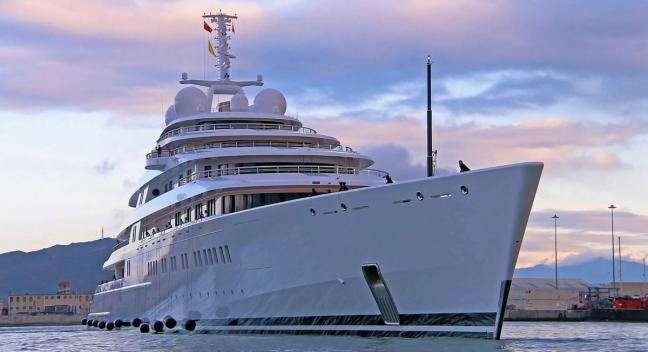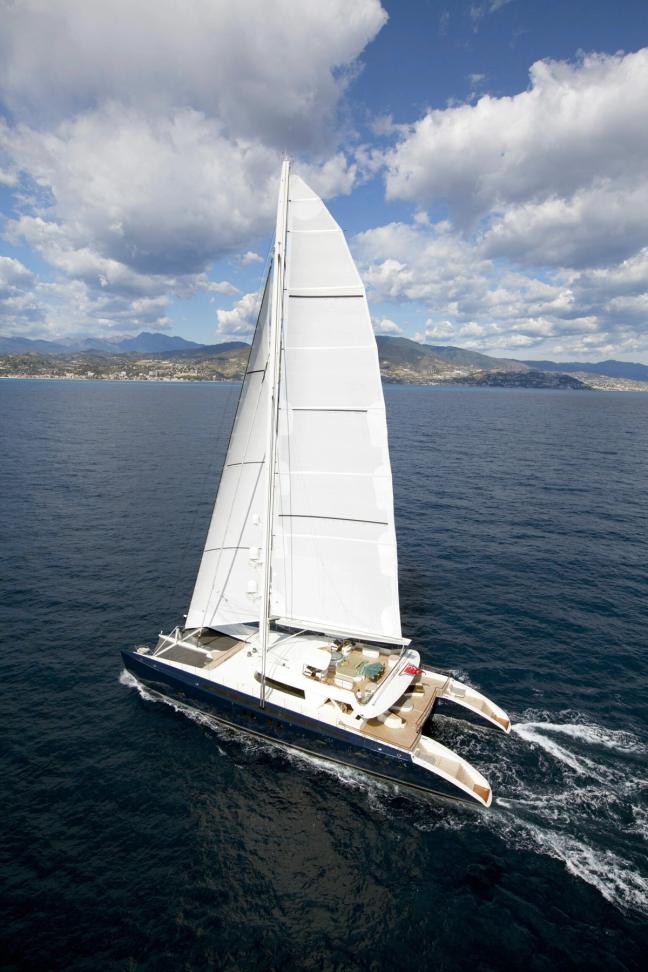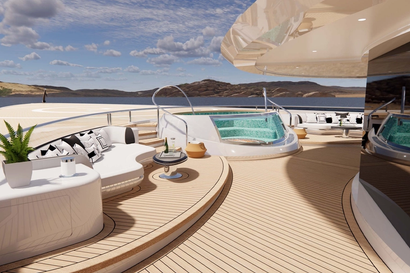Whatever the origin of the gentleman’s locker room bragging phrase “mine’s bigger than yours”, it continues to be a truism around the world and never more so in the world of yachts.
If reports are true, then somewhere in the world Triple Deuce, the largest and to date most expensive yacht ever, is under construction
If reports are true, then somewhere in the world Triple Deuce, the largest and to date most expensive yacht ever, is under construction. A yacht brokerage house based in Fort Lauderdale, USA, has disclosed that it has sold the gas turbine powered yacht and that it will be delivered to owners during 2018. Craig Timm, the broker supposedly responsible for selling this yacht has been quoted in magazines, newspapers and on the internet saying she would cost a record-breaking $1 billion to construct. Measuring 222 metres overall, with a crew of 100, she will be using azipod propulsion to achieve speeds in excess of 30 knots. Drawings show she is capable of accommodating up to 36 guests in four VIP suites and 12 double staterooms each with bathrooms containing gold taps, marble fittings and Jacuzzis. The yacht has been described by her broker as a Giga Yacht but what is it that makes her so? Is it the price, her length or the fact that she has a heli-platform, an enclosed gym with 360 degree views and carries a full time masseuse, hair stylist and barber along with ten jet skis and four speed boats?
‘What our client was concerned about is that if we built the yacht to 200 metres, then someone would come along like Roman Abramovich when he built Eclipse at 163.5 metres, to barely “eclipse” Sheikh Maktoum’s yacht, the 162-metre Dubai, by just 150 centimetres.’ said Timm. ‘By building the yacht to 222 metres, he wants to make it difficult, if not impossible, to be ‘eclipsed’ himself.’
How big is a superyacht and what comes next?
If Triple Deuce is described as a gigayacht, then what is a megayacht? How big is a superyacht and what comes next? With the advent of bigger and bigger yachts these new words and definitions are creeping into our vocabulary. According to the MCA Large Commercial Yacht Code (LY3) the word large when applied to yachts ‘means 24 metres and over in load line length’ but this is the only term that there appears to be industry agreement on, with the others being used depending on how the writer feels at the time.

German super yacht builders Lürssen delivered Azzam, the largest yacht in the world, to her new owners in October 2013. With a length of 180 metres and a top speed of over 30 knots she was built in record time taking less than one year of engineering followed by three years from first steel cutting.
Twenty five years ago, there were only around 300 yachts measuring 30 metres or more. Today there are believed to be more than 5,000. Mark T. Masciarotte of DSG Associates, Marine Consultants in the USA, is someone who has written on the subject of yachting for decades. He says, ‘There is, in fact, no objective definition of either the term megayacht or the term superyacht. These days, boating publications in the USA seem to set the lower threshold of a megayacht at around 30 metres, and superyacht at 45, and while these are both completely arbitrary, they are in direct contradiction of what is commonly used in Europe, where super yacht is the diminutive used for boats between 30 and 50 metres, mega is applied to those from 50 to around 65 and then giga, if used at all, is applied to anything bigger than that.
Joseph Gribbins, the founding editor of the US publication Nautical Quarterly, first coined the word megayacht in the mid-1980s to define a yacht that was so big almost no one on earth could afford to buy it. But he never defined the term beyond that. To complicate the vocabulary even further it has been suggested that the word superyacht was coined in England to distinguish yachts of a certain size from those in America since the word megayacht was considered to be too Americanised! This would suggest that the two words actually mean the same thing.
Roger Marshall, the freelance writer and former Chairman of the US-based Boat Writers Inc, has said that when he first got into the marine business in the early 1970s the largest yachts were maxiyachts, mostly used for racing under the IOR rule. They were around 24 to 26 metres long.
The first words a new owner normally says after taking delivery of his new yacht are: 'I wish I'd built her bigger'
Diane Byrne, publisher of megayachtnews.com, an Internet news magazine published in the USA, said: ‘The megayacht market is incredibly buoyant at the moment. But the first words a new owner normally says after taking delivery of his new yacht are: ‘I wish I’d built her bigger’.’

The world’s oldest surviving superyacht was built on the banks of London’s river Thames by Samuda Brothers and handed over to the Viceroy of Egypt, Isma’il Pasha her commissioning owner in 1865. Four years later she was the yacht that first commissioned the Suez Canal. Today she seldom leaves the docks and is used for hosting official delegations and diplomats by state officals in Egypt. Last time the yacht was seen outside Egypt was in 1976, when she took part in the United States bicentennial celebrations in New York.
Bill Sanderson, a well respected sales broker who started working in the yacht brokerage business in 1975, believes he has been around the industry longer than many. He also believes that it is best to keep the definition close at hand to keep track of everything and he prefers to refer to all boats in his business as yachts. Sanderson believes that all the terms from large to mega seem to be overlapping and redundant. He says, ‘For the new breed of very large yachts, those of 100 metres and upwards could legitimately be referred to as ‘giga’ yachts.’
'Superyacht' for a long time defined a yacht over 30 metres in length
Yacht designer Frank Mulder has used the word ‘superyacht’ for a long time defining it as a yacht over 30 metres in length. He believes that ‘the idea of connecting the definition to the 24 metre breakpoint is tempting but since the CE Rules and Classification Societies have always used 24 metres as a specific limit in length and one that has only recently became important for our industry I prefer to stick to my more than 30 metre definition to describe a superyacht.’
It is interesting that Mulder, whose first language is Dutch, not English, points out that the word mega means million, and the use of that word that suggests value rather than size. He believes that is where the term may have originated and megayachts were in fact the first superyachts ie those over 30 metres to cost over one million dollars. Given that giga is also a word attributed to numbers we are some way off building a gigayacht. Mulder believes the word super is used to describe a quality issue and that in his opinion should not be directly connected with a yacht of 24 metres. He would prefer superyacht to mean one whose length is between 30 and 45 metres, a megayacht be between 40 and 100 metres and the word gigayacht reserved for those of 100 metres and above.

Built in total secrecy and known only by the code name White Pearl the sailing yacht A is the world’s largest sailing yacht in the owrld. Built by Nobiskrug in Germany for the Russian billionaire Andrey Melnichenko. YA clocks up an overall length of 143 metres with a beam of 25 metres. Eight decks and a glass underwater observation window 20cms thick located in the keel are just two of the standout features of this yacht rumoured to cost $400 million.

Hemisphere is the largest privately owned vessel of her type in the world. She turns heads wherever she goes, due to her sheer scale. Completed by the British based Pendennis Shipyard, she is impressive because of the level of luxurious detail within her interior spaces and range of onboard facilities. Completed for the yacht’s owner, an avid diver, in 2011 she made her world debut at the Monaco Yacht show in September of that year to much acclaim. What makes the yacht special is the way shipyard craftsmen have balanced the inclusion of an impressive array of equipment with easy access to the many technical areas of the vessel.
Nick Griffiths, the managing director of the European yacht brokerage firm Ancasta, has said, ‘From my experience, it is the Russian oligarchs who are prone to building these boats as status symbols. Often they are more enthusiastic about the elaborate design of the boats than what they use them for. The market is awash with them right now and it’s the Russians who are driving it. For them it is all about who has got the longest boat, the highest mast and the best fittings.’
A superyacht is often referred to as such mostly because she is designed and built to a ‘superyacht’ quality indicating a higher degree of excellence that of a mere yacht. Alev Karagulle, from the London based yacht brokers Burgess, said, ‘superyachts have definitely become a competition thing.’
Over the years, yacht brokers and those writing the copy for their advertisements and sales brochures, who may have never heard of these definitions, have used the terms super yacht and mega yacht indiscriminately thus blurring their original meanings. As to what these terms really do mean, if they mean anything at all, is now, more or less, simply marketing terminology. While in English the concept of ‘mega’ being bigger than ‘super’ and ‘giga’ meaning anything bigger than that, unless they are defined they will continue to mean nothing. In the world of marketing consultancies it is often stated that the having of too many or nondescript terms frequently undercuts the supposed purpose. If this carries on the general public will remain clueless and most, if asked, will be dumbfounded by the use of giga which in truth is a word related to numbers, not size! Then there are the owners who, no longer wanting just a yacht, want something greater than that owned by their friend or rival. Immediately there is pressure to make up new names so that someone who used to have something special is not pushed out of that rarefied class when he upgrades. A megayacht owner would never settle for anything less grand when he builds a bigger yacht.
Britain and America are said to be divided by a common language and when it comes to very large yachts that may also be very true. Those from across the pond preferring the term Mega Yacht over the more European terminology that calls the same luxury vehicle a superyacht. British based Pendennis Shipyard builds yachts in Falmouth Cornwall. Founded by, the gentleman yachtsman Peter de Savery in 1988, the yard quickly flourished. Now 28 years after its inception, the yard is famed for having built 30 brand new superyachts and refitting over 200. They believe that ‘typically in the UK a superyacht is perceived to be a privately owned vessel, motor or sail, which has a length of over 24m, although some would argue it needs to be over 30m. A megayacht is the top end of the scale, referring to yachts of over 80m. It will be interesting to see if this distinction continues in the future, as the average LOA of yachts in the global superyacht fleet increases year on year.’
Our own straw poll of friends, colleagues and industry associates suggests the most commonly used definitions are:
Yacht: A generic term for all pleasure craft used in the boating community
Large Yacht: One whose length is 24 metres and above
Maxiyacht: A long fast sail racing yacht of modern design
Superyacht: British terminology for one whose length is between 24 and 85 metres
Megayacht: American terminology for one whose length is between 24 and 85 metres
Gigayacht: One whose length is 85 metres and above
This article was written by Frances and Michael Howorth for our 2016 supplement, Yachts

Become a Gentleman’s Journal Member?
Like the Gentleman’s Journal? Why not join the Clubhouse, a special kind of private club where members receive offers and experiences from hand-picked, premium brands. You will also receive invites to exclusive events, the quarterly print magazine delivered directly to your door and your own membership card.


